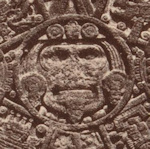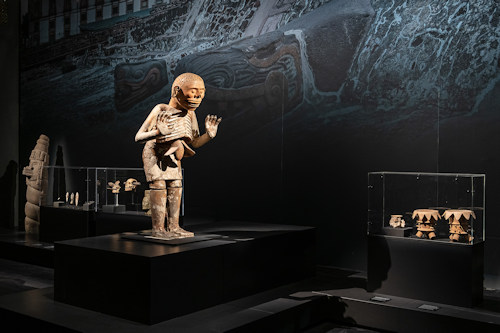
Words like Montezuma and Tenochtitlán seem strangely familiar. Yet most us have little true understanding of the culture of the times they come from: 15th and 16th century Mexico. The Aztecs – a new exhibition at the Weltmuseum – should change that.
- Takes you on a journey through the Aztec empire and into its most sacred locations
- Features over 200 Aztec objects from museums around the world
- Runs Oct 15, 2020 – Jun 22, 2021
- See also:
- Current exhibitions in Vienna
Following in the footsteps of Cortés

Some words from history immediately conjure up a rich tapestry of impressions.
Think Vikings, Julius Caesar, Shakespeare, and similar. The Aztecs certainly belong in that category, even though most of us probably know very little about this civilisation beyond exaggerated tales of human sacrifices and vague images of masks and temples.
Which is why we should probably pop down to the Weltmuseum for The Aztecs exhibition, which provides an enlightening introduction to the culture of an empire that dominated what is now central Mexico in the middle of the last millennium.
The exhibition comes to Vienna from another ethnographic museum: the Linden-Museum Stuttgart in Germany (who conceived and curated the exhibition in cooperation with the Nationaal Museum van Wereldculturen in the Netherlands and the Instituto Nacional de Antropología e Historia in Mexico).
That German event took place around the 500th anniversary of conquistador Hernán Cortés’s landing on the Mexican coast, and the exhibition follows a similar path to the Spanish.
We begin at the edges of Aztec influence and discover the cultural diversity of the area. Then we make our way into the depths of the Aztec empire itself, eventually reaching the capital, Tenochtitlán, and its temples.
Another theme that accompanies us on this journey is “tribute and sacrifice”, given their importance to the Aztec culture and economy.
Naturally, a vast array of historical exhibits serve to illustrate and educate as we walk the streets of 16th-century Mexico.
Masks, statues, jewelry, and similar bring the ideology, culture, economy, and religion of the Aztecs to life. It’s one thing to read about temple rituals, quite another to see an Aztec mask made from a human skull, flint, seashells and fool’s gold (and discovered in one such temple).
These items come from all over the world but include loans from, for example, Mexico’s Templo Mayor Museum: the institution dedicated to the “Great Temple” in Tenochtitlán.
Mexican scientists cooperated on the exhibition, helping ensure no misleading Eurocentric view clouds interpretation of Aztec artefacts and history.
The result is almost intimidating and provides the viewer with a far better understanding of Aztec culture in the wider, more sophisticated sense of the word.

(View of the Aztec exhibition © Foto: KHM-Museumsverband)
The exhibition certainly exposed my ignorance. For example, I had no idea that the Aztec empire actually consisted of an alliance of three city states with considerable social mobility and a hugely diverse population. They weren’t even called Aztecs.
Additionally, the monumental, almost strange (to the European eye), nature of some exhibits allows you to imagine how different the Aztec world must have seemed to the Spanish.
Sadness immediately follows this awareness: knowing that our so-called intellectual culture’s response to something different was to declare it universally inferior and then almost completely destroy it.
Exhibits from the Weltmuseum’s own collection complement the loaned items.
Be sure to view, for example, the unique and world-famous blue-green feather headdress likely worn by a priest during the reign of Aztec emperor, Moctezuma II (on display separately in its usual home in the Mesoamerica gallery: it’s apparently too delicate to risk moving).
This astonishing Aztec artefact has a diameter of almost 180cm and features over 1500 gold leaves, as well as feathers from such birds as the quetzal, cotinga, roseate spoonbill, squirrel cuckoo, and kingfisher.

(Quetzal-feather headdress; photo © KHM-Museumsverband)
Other items in the actual exhibition that particularly impressed me were:
- Copies of Aztec codices that brought the astonishing pictorial language of the culture to life
- A dark obsidian mirror used by Aztec seers (you can only imagine the kind of conversations such an item witnessed)
- A bird’s head mask covered in various materials that included jade and turquoises
- Almost alienesque statues of Mictlantecuhtli (God of Death) and a man dressed as a royal eagle
Dates, tickets & tips
Enjoy Aztec art and culture from October 15th, 2020 to June 22nd, 2021.
A normal entrance ticket gets you into all the Weltmuseum’s exhibitions (and, incidentally, also the historical collections of arms, armour and musical instruments in the same building). The Vienna Pass also includes the Weltmuseum, for example.
At the time of writing, you need a (free) timeslot ticket to view the exhibition, bookable online or, I’m guessing, at the museum ticket counter.
How to get to the exhibition
Just follow the travel tips at the bottom of the main article on the Weltmuseum. Once inside the museum proper, look for the exhibition galleries on the righthand side.
Address: Heldenplatz, 1010 Vienna